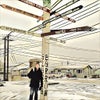The Vulcan statue is the largest cast iron statue in the world, and is the city symbol of Birmingham, Alabama, reflecting its roots in the iron and steel industry. The Шаблон:Convert tall statue depicts the Roman god Vulcan, god of the fire and forge. It was created as Birmingham's entry for the Louisiana Purchase Exposition (1904 World's Fair) in St. Louis, Missouri. It is the seventh-tallest free-standing statue in the United States.
Commissioned by the Commercial Club of Birmingham, Italian-born sculptor Giuseppe Moretti began designing the monumental figure in 1903, using a Шаблон:Convert tall model to study the form. He next sculpted a clay master model in an unfinished church in Passaic, New Jersey, and this was then divided into sections and transported by railroad to the Birmingham Steel and Iron Company for the preparation of casting molds for the iron.
The Vulcan statue consists of 29 cast-iron components with connecting flanges that are bolted together internally. The heaviest section is his whole head, which weighs Шаблон:Convert. Iron forgemen designed and executed the connection details for the statue, which originally had no internal framework and was self-supporting. The grey iron castings were made in Birmingham entirely from locally-produced iron.
The completed weight of the god Vulcan's figure alone is Шаблон:Convert. When Vulcan's anvil, block, hammer, and spearpoint are added, the statue weighs a total of Шаблон:Convert and it now stands on a pedestal that is Шаблон:Convert tall. The statue has a chest circumference of Шаблон:Convert and a waist circumference of Шаблон:Convert.
The statue was shipped to St. Louis as Birmingham's entry into the 1904 worlds fair. Vulcan dramatically demonstrated the mineral riches and manufacturing capabilities of the Birmingham area while on display in the Louisiana Purchase Exposition's "Palace of Mines and Metallurgy". It was awarded a "Grand Prize".
When the 1904 World's Fair ended, the Vulcan statue was dismantled and returned to its home city of Birmingham, only to be left in pieces alongside the railroad tracks due to unpaid freight bills.
The Vulcan statue was eventually re-erected at the Alabama State Fairgrounds, but the statue's arms were installed incorrectly, and the god was without his spear, which had been lost on the way from St. Louis.
With nothing to hold in its hands, Vulcan soon became an advertising figure. Over the years, Vulcan held an ice cream cone, a Coca-Cola bottle, and even Heinz pickles. In the late 1920s, the statue was disassembled for inspection. During this time, children would often play around the disassembled statue. It was painted a flesh color and was reassembled in the early 1930s.
It was not until 1936 that the statue found a suitable home, thanks to the Works Progress Administration, which partially funded a new park in the city at the top of Red Mountain. A Шаблон:Convert pedestal was built of local sandstone, and Vulcan was hoisted into place. A new spear was fabricated to be held high in his right hand while his left hand held a hammer at his side. Vulcan was repainted in an aluminum like finish. The statue's naked buttocks have been source of humor for many years. A novelty song, "Moon Over Homewood," refers to the fact that the statue "moons" the neighboring suburb of Homewood, Alabama.
A nine day festival commenced on May 7, 1939 to dedicate Vulcan Park. Miss Evelyn Tully was crowned the Vulcan Queen. Guests of honor included the foundrymen who originally cast Vulcan. A crowd of 5,000 was present for the opening night of the festival.
To take full advantage of Vulcan's position overlooking Birmingham, the city's Junior Chamber of Commerce in 1946 made the statue into a symbol for road safety. His spear was replaced by a neon torch that glowed green, except during the 24 hours following a fatal traffic accident, when it glowed red. The spear was restored after the 1999-2004 restoration.
In 1949, Vulcan gained new neighbors, when two television stations, WAFM-TV (now WVTM) and WBRC located their studios and towers on Red Mountain.
To celebrate Birmingham's centennial, the area around the statue was given a $1 million facelift in 1971. The original tower was clad in Alabama marble with an elevator and observation deck added. A covered walkway also connected a gift shop and snack bar. Vulcan was repainted a rust red a few years later. Vulcan was listed on the National Register of Historic Places on July 6, 1976.
Unfortunately, the statue itself had, when originally placed atop the pedestal, been filled up to the chest with concrete and had begun to deteriorate seriously due to different expansion and contraction rates of concrete versus cast iron. By 1990, an engineering study found that the statue was in danger of collapse.
Vulcan was removed during October and November 1999 in preparations for a $14 million renovation process that saw the park and pedestal restored to its original 1938 appearance. The statue sat in Vulcan Park's parking lot until the fall of 2001, when it was shipped to Robinson Iron to be repaired. The statue itself was thoroughly inspected and repaired, with some parts, including the lost spear point, re-cast. The new and restored pieces were thoroughly coated with a durable paint system, including a light-gray finish coat dubbed "Vulcan Gray" by the specifier.
Meanwhile in 2002, the 1971 park additions were demolished, and scaffolding went up around Vulcan's tower. Workmen cleaned and repaired the original tower. Vulcan's head and right arm went on display at the Birmingham Museum of Art while the tower was prepared.
Vulcan was re-erected on a steel armature atop his tower during June 2003, restored to its original appearance as intended by Moretti, slightly reoriented to the east. Television stations WVTM and WBRC both provided live webcams of the reinstallation.
Shortly after the statue was reinstalled, the scaffolding came down, and a new observation deck, providing panoramic views of the area, was installed. The museum at the base was rebuilt, though it now serves as a storage area. A new elevator was installed, but oriented so it would not be easily seen from downtown Birmingham. The original waterfalls were not rebuilt, though the stone walkways leading from the parking lot directly to Vulcan's tower were restored. The statue and park were officially reopened in 2004, celebrating Vulcan's 100th birthday. In 2004, Vulcan Park welcomed more than 100,000 visitors who enjoyed the statue's spectacular view of downtown Birmingham.
The restoration project received a National Preservation Honor Award from the National Trust for Historic Preservation in 2006.
Vulcan Park and Museum (VPM) features spectacular views of Birmingham, an interactive history museum that examines Vulcan and Birmingham's story, a premier venue for private events and a beautiful 10-acre (4 ha) urban green space for visitors and locals to enjoy. Free wireless internet access is available on park grounds during park hours. In May 2007, Vulcan Park and Museum was designated an official Birmingham Information Center by the Greater Birmingham Convention and Visitors Bureau and offers information on transportation services, restaurants, events and other cultural offerings in Birmingham.
Vulcan Center Museum: Vulcan Center Museum serves as the primary educational component of VPM and tells the story of Birmingham's "magical" creation and storied past. Visitors learn about the discovery of three key ingredients that drove the growth of our region – coal, limestone and iron ore. They explore what life was like for mine workers in company towns and take a trip back in time by visiting a replica of a typical company store. A large scale photograph of the Empire Building, one of Birmingham's best-known skyscrapers, is held in place by replicated steel girders illustrating how Birmingham grew to be the industrial center of the South. VPM's most important artifact is the 56-foot tall statue of Vulcan that stands proudly outside Vulcan Center Museum. The story of Vulcan's life story from the statue's creation in record time for the 1904 World's Fair in St. Louis to its importance as a symbol for the people of Birmingham and Alabama today is told through hands-on, interactive displays. Exhibits invite visitors to learn about the process of the statue's creation from Italian-born artist Giuseppe Moretti's first clay model to the unprecedented casting of over 100,000 pounds of iron to create the colossal ironman in final form. A full-size replica of Vulcan's foot, cast in fiberglass, gives visitors a sense of the scale of the statue. Other areas of the museum discuss the Great Depression's impact on the city's industrial production and examine Birmingham's involvement with the Civil Rights Movement. Linn-Henley Gallery, located within the museum, features changing exhibits that broaden and offer fresh perspective on a variety of topics related to Birmingham.
Field Trips and Educational Programs: Vulcan Park and Museum offers a variety of educational programs and has become a popular destination for school field trips. All programs are aligned with the Alabama Course of Study and contain lessons in social studies, language arts, math, science and fine arts. Both Guided and Self-Guided school tours are available on weekdays throughout the year. In addition, VPM offers collaborative field trips with related Birmingham attractions (Sloss Furnaces National Historic Landmark, Birmingham Civil Rights Institute, or Ruffner Mountain Nature Center) and programs that bring the story of Vulcan to life through theatre, dance and musical performances.
Special Events: Throughout the year, Vulcan Park and Museum hosts a variety of public events including:
•Vulcan's Annual Birthday Bash – On the first Sunday in June, Vulcan Park and Museum is transformed into a festival atmosphere in celebration of Vulcan's birthday. Visitors have the opportunity to enjoy food, balloons, clowns, local musical entertainment and fun activities. This family-friendly event celebrates the anniversary of Vulcan's original dedication at the 1904 St. Louis World's Fair.
•Thunder on the Mountain 4th of July Fireworks Extravaganza – In June 2007, Vulcan Park and Museum took the lead role in organizing this spectacular Fourth of July celebration, which is the largest fireworks show in the state of Alabama. Vulcan Park and Museum closes at 6 p.m. on July 4 each year to set up for the show. Fireworks are shot from the park grounds and Vulcan's Observation Balcony. An official soundtrack that is synchronized with the show is broadcast on local radio stations and the fireworks show is televised live on a local news station.
•Vulcan AfterTunes Concert Series – Vulcan AfterTunes is a three-part concert series that is a unique and widely popular community event. Concerts featuring nationally-acclaimed singer/songwriters are performed on the City Overlook with the Birmingham skyline as a stunning backdrop.
Vulcan's Gift Shop: Home to unique items featuring Birmingham's favorite icon and the Magic City, Vulcan's Gift Shop has something for everyone! Vulcan's Gift Shop is located inside Vulcan Center Museum and is open seven days a week. Select items are also available online. Gift Shop hours coincide with Museum hours.
Vulcan Park and Museum is operated by Vulcan Park Foundation, a non-profit organization with a mission to preserve and promote Vulcan as the symbol for the Birmingham region, to advance knowledge and understanding of Birmingham's history and culture, and to encourage exploration of the region. Our offices are located inside Vulcan Center.
Notes Шаблон:Reflist
Bibliography





